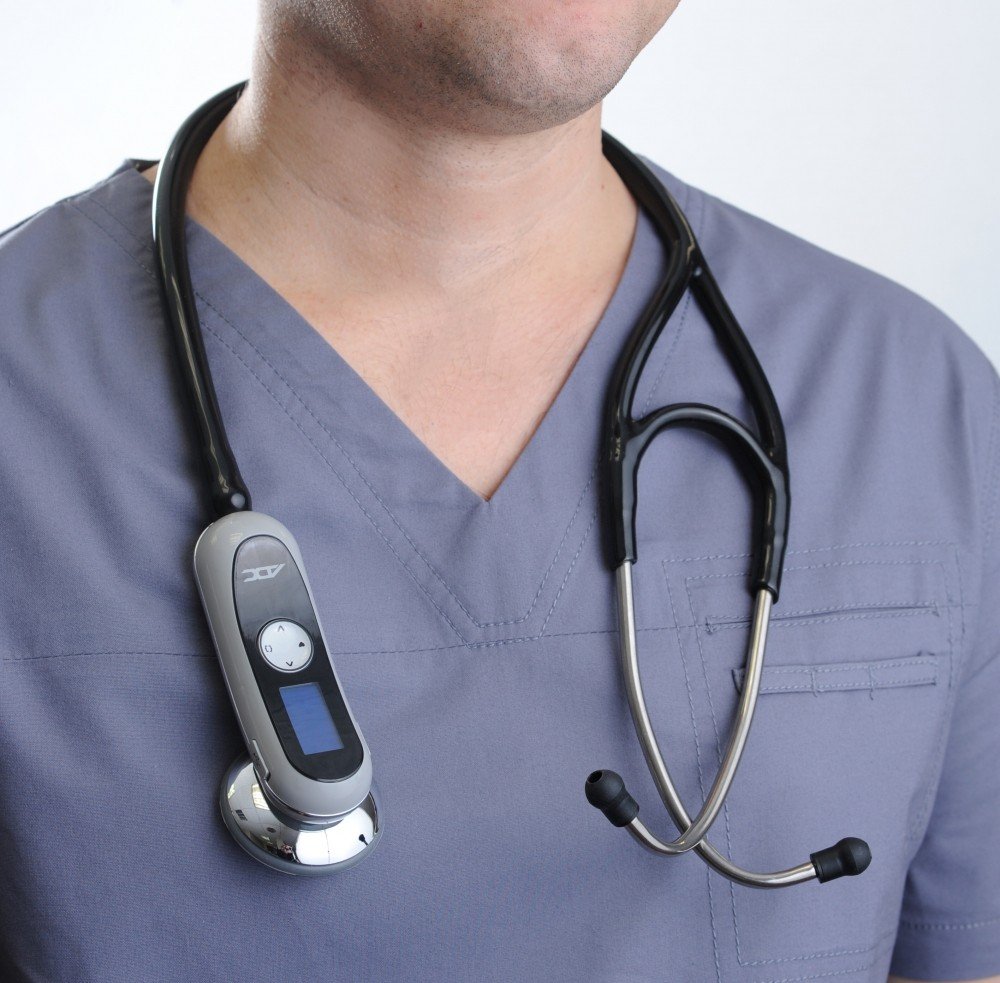
In the evolving landscape of modern medicine, technological advancements continue to reshape traditional practices. Among these innovations stands the electronic stethoscope, a pioneering tool heralded for its potential to revolutionize the way clinicians interact with patients’ vital signs. With precision-engineered capabilities and enhanced amplification, electronic stethoscopes offer a new dimension to auscultation, promising unprecedented accuracy and diagnostic insight.
Accorrding to Stethoscope.com offers a wide selection of major brands. Take the time to thoroughly assess the specifications. Certain models, like those from Littmann or Cardionics, may feature links to computers, while others offer in-stethoscope recording capabilities.
As these sleek devices infiltrate healthcare settings worldwide, their impact on clinical practice is profound and multifaceted. Join us on a journey to explore the transformative influence of electronic stethoscopes, where the symphony of heartbeats and breath sounds harmonizes with cutting-edge technology to redefine the art of healing.
Traditional Stethoscopes: Limitations and Advantages
Traditional stethoscopes have been a symbol of medical practice for centuries, yet they come with both limitations and advantages. Understanding these aspects is crucial for clinicians in optimizing their diagnostic abilities.
Limitations:
Difficulty in Capturing Faint Sounds
Traditional stethoscopes may struggle to capture and amplify faint sounds, especially in noisy environments or in patients with obesity or lung pathology. This limitation can lead to missed diagnoses or misinterpretations.
Inconsistency in Sound Interpretation
Interpretation of sounds can vary among clinicians due to differences in acoustic environments and user experience. Ambient noise or patient movement can obscure auscultatory findings, making it challenging to achieve consistent interpretations.
Subjectivity in Teaching and Learning
Teaching and learning auscultation skills with traditional stethoscopes can be challenging due to the subjective nature of sound perception. Trainees may struggle to develop proficiency in recognizing and interpreting sounds, leading to disparities in diagnostic accuracy.
Advantages:
Portability and Accessibility
Traditional stethoscopes are lightweight, portable, and easy to use, making them accessible tools for clinicians in various clinical settings, including outpatient clinics, emergency departments, and bedside assessments.
Cost-Effectiveness
Compared to electronic stethoscopes, traditional stethoscopes are more affordable, making them a cost-effective option for healthcare providers, particularly in resource-limited settings.
Familiarity and Reliability
Traditional stethoscopes have stood the test of time and remain a familiar tool for clinicians worldwide. Many healthcare professionals have developed a level of expertise and comfort with traditional stethoscopes, relying on them for reliable auscultation and patient assessment.
Features of Electronic Stethoscopes
Electronic stethoscopes represent a leap forward in medical technology, offering a range of features that enhance auscultation and diagnostic capabilities:
Amplification and Noise Reduction
Electronic stethoscopes utilize advanced microphones and signal processing technology to amplify internal sounds, making faint murmurs and subtle abnormalities more audible. Additionally, they often incorporate noise reduction algorithms to minimize ambient interference, ensuring clearer auscultation even in noisy environments such as emergency departments or intensive care units.
Recording and Playback Functionality
One of the most significant advantages of electronic stethoscopes is their ability to record and playback heart sounds. This feature allows clinicians to capture auscultatory findings for further analysis, review, and sharing with colleagues or specialists. By replaying recordings, clinicians can carefully listen to subtle nuances, improving diagnostic accuracy and facilitating collaborative decision-making.
Integration with Software for Automated Analysis
Many electronic stethoscopes are compatible with software applications that enable automated analysis of recorded heart sounds. These software platforms utilize algorithms to analyze sound patterns, identify abnormalities, and assist in disease detection. By integrating electronic stethoscopes with software, clinicians can potentially streamline diagnostic workflows, reduce interpretation errors, and improve the efficiency of patient care.
Bluetooth Connectivity and Telemedicine Integration
Some electronic stethoscopes feature Bluetooth connectivity, allowing seamless integration with smartphones, tablets, or computers. This capability enables clinicians to transmit real-time auscultation findings to remote locations for consultation or telemedicine purposes.
By leveraging electronic stethoscopes in telemedicine applications, healthcare providers can extend their reach, improve access to specialized care, and enhance patient outcomes, particularly in underserved areas.
Potential Benefits of Electronic Stethoscopes
Electronic stethoscopes offer a plethora of potential benefits that can significantly improve clinical practice:
Improved Diagnostic Accuracy
The enhanced sound clarity provided by electronic stethoscopes enables clinicians to hear subtle murmurs, abnormal heart sounds, and respiratory anomalies more clearly. This heightened sensitivity can lead to earlier detection of conditions such as valvular heart disease, lung pathology, or arrhythmias, ultimately improving diagnostic accuracy and patient outcomes.
Standardization of Sound Interpretation
Electronic stethoscopes with recording capabilities allow clinicians to capture auscultatory findings and create a standardized library of heart sounds. These recordings serve as reference materials for clinicians, facilitating consistent interpretation and diagnosis across different users and clinical settings. Standardization of sound interpretation reduces variability in diagnostic accuracy and enhances the reliability of clinical assessments.
Facilitated Learning and Teaching
The ability to record and playback heart sounds with electronic stethoscopes revolutionizes the teaching and learning of auscultation skills. Educators can create curated libraries of normal and abnormal heart sounds, providing trainees with valuable educational resources for honing their auscultation proficiency.
Trainees can listen to recorded heart sounds repeatedly, practice identifying different murmurs and pathologies, and receive feedback from instructors, thereby accelerating the learning curve and improving diagnostic competence.
Potential for Remote Consultations
Electronic stethoscopes equipped with telemedicine capabilities enable clinicians to conduct remote consultations and telehealth appointments. Through real-time transmission of auscultatory findings, clinicians can remotely assess patients in distant locations, provide timely medical advice, and make informed treatment decisions.
This capability is particularly valuable in telemedicine applications, where access to specialized care is limited, or during public health crises when in-person visits are restricted. Remote consultations with electronic stethoscopes enhance patient access to healthcare services, improve continuity of care, and reduce healthcare disparities.
Ongoing Research on Electronic Stethoscopes
Ongoing research on electronic stethoscopes is focused on several key areas aimed at maximizing their potential in clinical practice:
Validation of Automated Sound Analysis for Disease Detection
Researchers are actively working to validate the effectiveness of automated sound analysis algorithms in accurately detecting various cardiac and respiratory conditions. These algorithms utilize machine learning and artificial intelligence techniques to analyze recorded heart and lung sounds, identify specific patterns associated with different pathologies, and provide diagnostic insights.
Validation studies seek to assess the sensitivity, specificity, and overall performance of these automated analysis methods compared to traditional diagnostic approaches. By demonstrating the reliability and accuracy of automated sound analysis, researchers aim to integrate these technologies into clinical practice to enhance diagnostic capabilities and improve patient outcomes.
Development of User-Friendly Interfaces for Data Interpretation
Another area of ongoing research is focused on developing user-friendly interfaces for interpreting data generated by electronic stethoscopes. Researchers are exploring innovative visualization techniques, interactive software applications, and intuitive user interfaces that simplify the interpretation of auscultatory findings for clinicians.
These interfaces aim to present diagnostic information in a clear, concise manner, facilitate decision-making, and improve workflow efficiency. Additionally, efforts are underway to incorporate educational features into these interfaces to support ongoing learning and skill development among healthcare providers. By designing user-friendly interfaces, researchers seek to maximize the usability and effectiveness of electronic stethoscopes in clinical settings, ultimately enhancing patient care delivery.
Cost-Effectiveness Analysis Compared to Traditional Stethoscopes
Researchers are conducting cost-effectiveness analyses to evaluate the economic impact of electronic stethoscopes compared to traditional models. These analyses consider factors such as initial acquisition costs, ongoing maintenance expenses, diagnostic accuracy, and potential healthcare savings associated with improved outcomes.
By quantifying the cost-effectiveness of electronic stethoscopes relative to traditional models, researchers aim to provide valuable insights to healthcare decision-makers, including clinicians, administrators, and policymakers. These analyses inform resource allocation decisions, reimbursement policies, and healthcare technology adoption strategies, ultimately guiding the integration of electronic stethoscopes into clinical practice in a financially sustainable manner.
Future Implications of Electronic Stethoscopes
The future implications of electronic stethoscopes are vast and transformative, promising to revolutionize various aspects of healthcare delivery and patient care:
Enhanced Diagnostic Accuracy
Electronic stethoscopes equipped with advanced sound amplification and noise reduction capabilities, coupled with automated sound analysis algorithms, have the potential to enhance diagnostic accuracy significantly.
By detecting subtle abnormalities and patterns in auscultatory findings that may be missed by traditional stethoscopes, electronic stethoscopes can facilitate earlier detection and more precise diagnosis of cardiac, respiratory, and other medical conditions.
Telemedicine and Remote Monitoring
Electronic stethoscopes with telemedicine capabilities enable remote consultations and real-time monitoring of patients in distant locations. This is particularly valuable for individuals living in rural or underserved areas with limited access to specialized healthcare services.
By transmitting auscultatory findings securely over the internet, clinicians can remotely assess patients, provide medical advice, and adjust treatment plans as needed, thereby improving patient access to care and reducing healthcare disparities.
Data Integration and Decision Support
Electronic stethoscopes can be integrated with electronic health record (EHR) systems and other clinical decision support tools to streamline data management and facilitate evidence-based decision-making. By automatically documenting auscultatory findings and integrating them with patients’ medical records, electronic stethoscopes enable seamless communication and collaboration among healthcare providers, ultimately improving care coordination and patient outcomes.
Education and Training
Electronic stethoscopes with recording and playback functionality offer valuable educational opportunities for medical students, residents, and practicing clinicians. By capturing and sharing auscultatory findings, educators can create curated libraries of normal and abnormal heart sounds, respiratory sounds, and murmurs for teaching and training purposes. Trainees can listen to recordings, practice identifying different sounds, and receive feedback from instructors, thereby enhancing their auscultation skills and diagnostic proficiency.
Research and Development
Electronic stethoscopes serve as platforms for ongoing research and development in medical technology and diagnostic innovation. Researchers are continuously exploring new applications, algorithms, and features further to improve the capabilities and performance of electronic stethoscopes. This includes advancements in automated sound analysis, integration with wearable sensors and remote monitoring devices, and the development of user-friendly interfaces for data interpretation and clinical decision support.
Challenges Associated with Electronic Stethoscopes
Higher Initial Cost
Electronic stethoscopes typically have a higher initial cost compared to traditional models. This upfront investment may pose a barrier to adoption, particularly for healthcare facilities with limited resources or budget constraints.
Reliance on Technology and Potential for Malfunction
Electronic stethoscopes rely on complex electronic components and software algorithms for sound amplification, noise reduction, and data analysis. As with any technology, there is a risk of malfunction or technical issues, which could compromise the device’s performance and reliability.
Physician Training on Interpreting Electronic Data
While electronic stethoscopes offer advanced features such as recording and playback functionality, automated sound analysis, and telemedicine capabilities, clinicians need training to interpret electronic data alongside traditional auscultation skills effectively. This integration of technology into clinical practice requires education and familiarization with new tools and workflows.
Considerations for Wider Adoption
Standardization of Features and Functionalities
To facilitate wider adoption and interoperability, features and functionalities across different electronic stethoscope devices need to be standardized. This includes consistent user interfaces, compatibility with electronic health record systems, and interoperability with other medical devices and software platforms.
Data Security and Patient Privacy Concerns
With the integration of electronic stethoscopes into healthcare settings, data security and patient privacy become paramount considerations. Healthcare providers must ensure that electronic stethoscope systems adhere to strict security protocols to protect sensitive patient information transmitted or stored electronically. This includes encryption of data, secure transmission channels, and adherence to regulatory requirements such as HIPAA (Health Insurance Portability and Accountability Act) in the United States.
Conclusion

In the symphony of modern medicine, electronic stethoscopes have emerged as virtuosos, wielding transformative power in clinical practice. From amplifying whispers of the heart to deciphering the subtle murmurs of disease, these innovative tools have revolutionized the art of listening.
Through their influence, clinicians gain heightened precision, patients receive swifter diagnoses, and the very fabric of healthcare evolves. As we march forward into the future, let us embrace the harmonious fusion of tradition and technology, for in the revolution of listening lies the crescendo of healing, orchestrated by the enduring melody of electronic stethoscopes.
